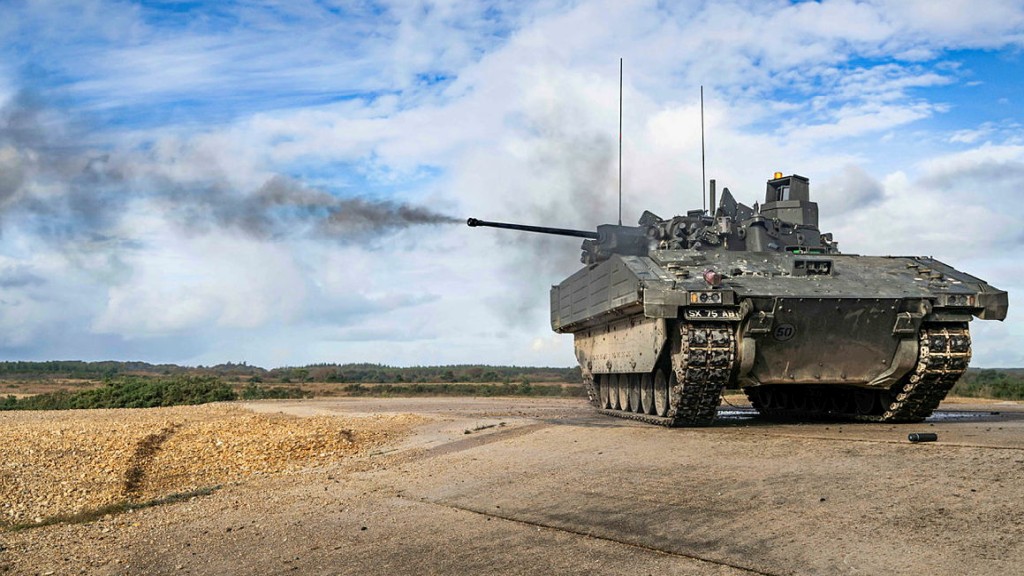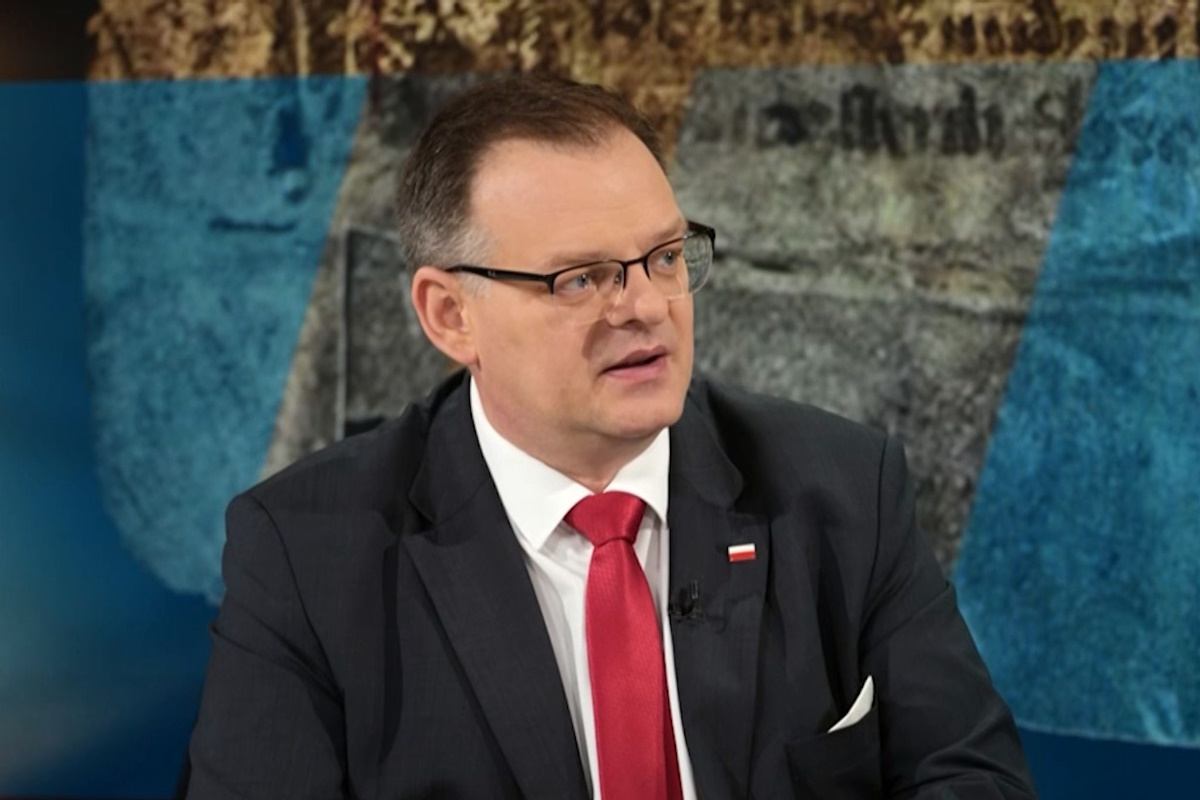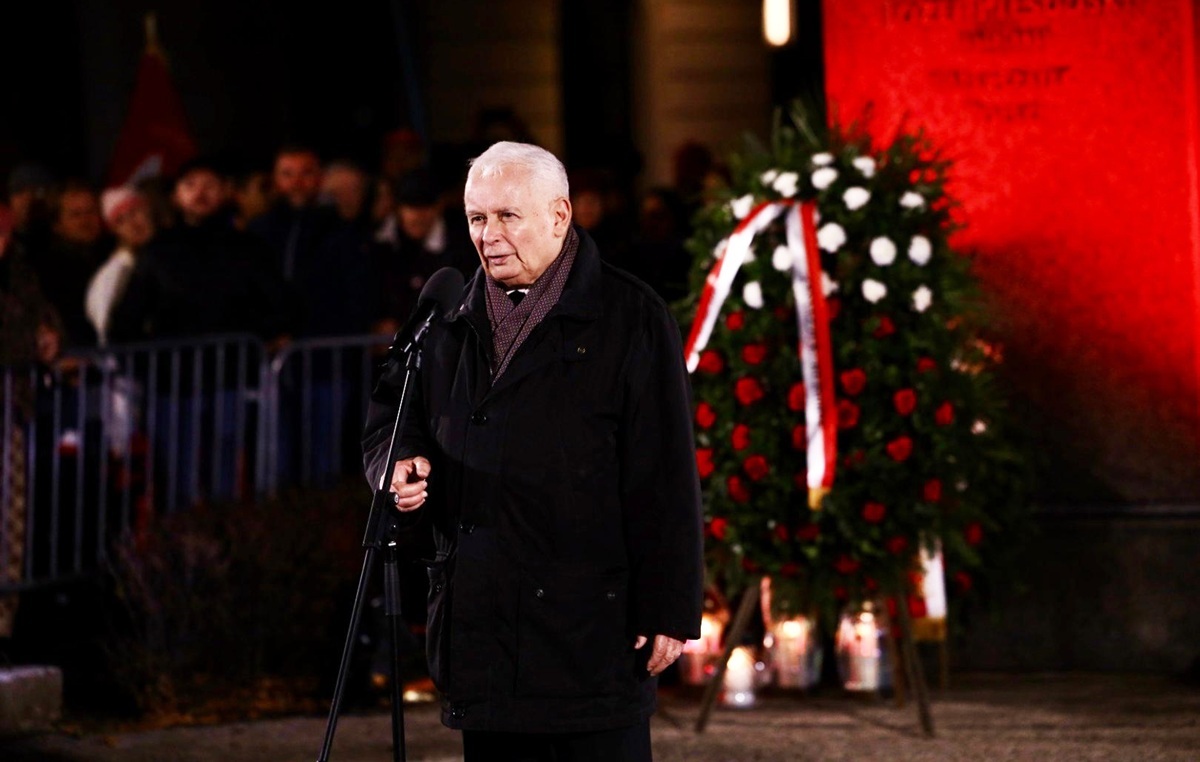The Polish army has not conducted operations on such a scale for decades. First, thousands of soldiers were deployed to the south of Poland to fight the flood, then, when the great water fell, cleaning and reconstruction began.

The crane arrived at Głuchołazy in the middle of the night. There, it was made heavier with an additional load and was ready to start working at dawn. At 7.00 am the first element of the bridge went up. Specialists assessed its condition, checked whether it bends in the right way and whether it can be safely put on the previously prepared bridgeheads. “It required great precision,” admits LtCol Arkadiusz Syrocki, Deputy Commander of the 2nd Engineer Regiment, who supervised the task. “The crane operator had to precisely fit in the bearings installed on the bridgeheads,” he adds. Within a few hours, the temporary DMS-65 bridge connected both banks of Biała Głuchołaska River.
However, the construction did not end there. Over the following days, the soldiers laid nearly 150 road plates on the construction structure, each of them weighed 220 kg. Although the elements were handed by the crane, the assembly itself was a tedious, manual work. Simultaneously, a civilian company cooperating with the army installed driveways for cars. Finally, the bridge was introduced for use at the end of October. For the locals, the first cars passing over the river bridge were a sign that normality is slowly returning to Głuchołazy.

The crossing itself consists of two lanes, is 36 m long and has a load capacity of over 40 tons. “We train for similar tasks on a regular basis. We do such tasks mainly for the army, but we have the experience of such interventions gained during natural disasters. We constructed temporary crossings 11 years ago in Jelenia Góra and a year ago after the flood in Slovenia. One can say that the bridge construction is a daily bread for us,” admits LtCol Syrocki. Yet still, the work in Głuchołazy is unique, not only because of the huge emotional load. The erection of the bridge was one of the most important tasks of Operation Phoenix (Operacja Feniks), which in the recent history of the Polish army is an unprecedented undertaking.
Faster Than Waves
The drama took place right before the eyes of all the people in Poland. The coverage on the flood was being broadcast live on 24/7 news channels and online websites non-stop. The grayish water from the swollen river literally washed two bridges away – a solid concrete one, which had been under renovation for some time, and the temporary one built nearby. The bridges fell apart like houses of cards and disappeared in the gushing water current. The town of Głuchołazy is located around two banks of the river, and in an instant the town got cut in half. A destruction of the two bridges in Głuchołazy became a symbol of the cataclysm that hit Poland in early September. Not the only one. The water flooded several districts of Kłodzko, ravaged Lądek-Zdrój, and wiped a large part of Stronie Śląskie off the face of the earth. Hundreds of towns suffered in the flood – mainly in the Opole region and Lower Silesia, but also in the Silesian or Lubuskie voivodeships.

From the very beginning, the army was involved in the struggle with the flood. Soldiers from several brigades of the Territorial Defense Forces, but also operational troops, were deployed in sensitive areas. Floating self-propelled transporters appeared on flooded streets, helicopters soared into the air. The soldiers helped to strengthen the embankments, evacuated the inhabitants, provided food and drinking water, and monitored the condition of rivers and reservoirs, often with the use of the most modern equipment. Above the endangered areas, for example, one of the latest acquisitions of the Polish Armed Forces – the Bayraktar drone from the 12th Unmanned Aerial Vehicles Base in Mirosławiec. The images recorded by the drone were directly transmitted to the crisis team. With that, it was possible to monitor the condition of the shafts more effectively.
The number of soldiers involved in the fight against the flood would grow practically every day. “The military had not conducted an operation on this scale for decades. At the peak of the operation, nearly 26,000 soldiers were deployed for it. For comparison, on the border with Belarus, there are stationed from 4,000 to 5,000 troops on a daily basis,” points out BrigGen Krzysztof Stańczyk, Commander of the Territorial Defense Forces, who from the first days commanded them. “Initially, the biggest challenge for us was logistics. A huge group of soldiers had to be deployed outside their home units, so we had to organize food and accommodation for them,” he emphasizes. A bit of creativity and some planning skills helped. “For some time, 3,000 soldiers slept in the Centennial Hall lent by the Wrocław authorities. We also use, among others, the barracks in Brzeg or Oleśnica, and found accommodation in the spa hospital in Lądek-Zdrój,” enumerates BrigGen Krzysztof Stańczyk. A mobile feeding system was also quickly launched. The soldiers began to use field kitchens and canteens in tents. Wherever such a system was impossible to implement, the Armed Forces Support Inspectorate came to an agreement with local catering companies and paid for catering.
Only that, creating the infrastructure was just a starting point. The military passed the flexibility test, which turned out to be crucial in the essential part of this operation. For the first days and weeks, the pace of events was extremely fast. Decisions often had to be made practically on the spot, and not just about the deployment of new forces. “The flood wave was moving north, and we had to be a step ahead of it. We moved some of the subdivisions with the PTSs (tracked amphibious transport vehicles) to the place where they were most needed at the moment. Wrocław, Oława, Głogów, Krosno Odrzańskie... There, we managed to be ahead of the great water. The Odra River remained in the trough,” reports Col Krzysztof Jaroszek, Commander of the 1st Sapper Regiment, and now Commander of the Task Group of the Engineering Forces, who has been involved in the fight against the flood from the very beginning.

Soldiers themselves, however, often participated in dramatic scenes. Maj Wojciech Tyniec from the 1st Sapper Regiment assigned to the areas affected by the flood arrived at the scene on September 13, practically straight from the training field. He became the Commander of the ‘Opole’ Engineering Task Group. Initially, the group included 35 soldiers, but at one point this number increased to nearly a hundred. With their PTSs, soldiers transported sandbags, food, evacuated locals from flooded households, and pumped water out of floodplains that formed wherever the embankments were destroyed. “To this day, in my mind I see the images of the completely flooded village of Wronów. A man stands up to his neck in the water, holding bags with his belongings above his head. There were people who first would refuse to be evacuated for a long time and then tried to save whatever they could... Sometimes people had to leave their houses in a hurry, leaving their animals behind. One of my soldiers took in the dog, though for a short time, because just a few days later the owner was found. These were really moving situations,” the officer recalls.
In a similar tone speak helicopter crews who operated in the south of Poland from September 14. At one point, the aviation component consisted of 19 machines of different types – from Mi-17 to Black Hawk. The crews spent a total of about 250 hours in the air. On short videos shared, among others, by the Armed Forces General Command, you can see how aviators descend on ropes to the roofs of houses, to these ropes they attach residents, who are then pulled up onboard helicopters. “These were not ordinary flights. We were all accompanied by a lot of emotions at the time. It couldn’t be different when you realize that the health and sometimes the lives of evacuated people depend on your actions,” emphasizes Col (Pil) Krzysztof Zwoliński, Deputy Inspector of the Polish Air Force, who coordinated the work of the air component designated for activities in flood-affected regions.
Meanwhile, the flood has been tamed. The Odra River did not flood either Opole or Wroclaw. The water dropped to safe levels. The military, however, did not return to the barracks.
Great Clean-Up After the End of the World
On September 23, Operation Phoenix began. Goal: to remove the effects of the disaster and rebuild the destroyed infrastructure. Why was this task assigned to the army? “The scale of destruction is so serious that local governments will not manage without state aid. Time is also important. The task must be completed as quickly as possible, and the army has the power and resources to do it,” convinces BrigGen Krzysztof Stańczyk. The command of the operation has been stationed in Wrocław. The command supervises three task groups – engineering, logistics and TDF troops. In cooperation, they are an effective working mechanism.

Until recently, the first thing to do in the flooded areas was a great clean-up. “Water carried broken trees, stones, rubble from destroyed buildings and bridges. After it gushed through the towns, there were huge amounts of sludge on the roads and streets. It was like that everywhere, from Nysa to Lewin Brzeski. Previously, I had the experience of removing the effects of the 1997 and 2010 floods, but I must say I do not remember such an amount of mud and liquid wastes,” points out LtCol Gabriel Wasilewski, who serves in the 8th Home Army Infantry Division on a daily basis, and during Operation Phoenix became the Deputy Commander of the Engineering Forces Task Group. Not so long ago, only in Głuchołazy alone, the army would load 120 trucks a day with waste. The flood water demolished not only the streets, squares or building facades. Apartments were also often destroyed. “In many towns and villages in our region, we would set up big bags in front of the properties, i.e. large containers, which would get filled with waste practically in one day. The waste was transported to the landfill in Lewin Brzeski. It covered an area of two hectares,” reports Maj Wojciech Tyniec.
But cleaning alone is only part of the activity. The flood water flooded cemeteries, carried dead animals, soaked buildings and roads with pathogens, turning them into a bacteriological bomb with delayed ignition. Disinfection was a must. This task was assigned to chemical units. “350 soldiers were deployed to Operation Phoenix, and they were divided into 18 task teams. We now operate throughout the flood-affected area. In Stronie Śląskie, Głubczyce, Kłodzko...,” enumerates LtCol Antoni Półtorak, Deputy Commander of the 5th Chemical Regiment in Tarnowskie Góry, who during Operation Phoenix commands army chemists. Soldiers use decontamination vehicles with sanitary installations to clean outer parts of facilities, and inside buildings they use backpack sprayers. “We use a chemical agent based on active chlorine. Soldiers disinfect the flood-affected surfaces meter by meter, and then rinse them with warm water,” says the Lieutenant Colonel. By mid-October, the army chemists had disinfected more than 1.3 million square meters of area, including nearly 190 km of roads. “We are also eliminating well contamination. So far, we have disinfected almost 300 of wells,” explains LtCol Antoni Półtorak.

The military chemists are accompanied by medical support. In the flood-affected regions, mobile teams operate to vaccinate people against tetanus, typhoid, hepatitis. Specialists deployed by military preventive medicine centers have already vaccinated nearly 3,000 people. Over 1,100 patients also underwent treatment at a temporary hospital erected by the army in Nysa.
Restoring normality also means removing communication barriers. To help residents, you need to have easier access to them. The army troops are fixing the roads. Bridges are also crucial – including those that survived the flood. The fact that they have not been washed away by water does not mean that they are safe. The rivers still carry the remains after the flood, which can turn out to be extremely dangerous. “We had an example of this on Nysa Kłodzka near Lewin. The current carried an almost 30-meter long knocked-down tree. It was turned around in such a way that it blocked the trough. It could have dumped up water or destroyed the structure of a nearby bridge. We had to take it out,” explains Maj Wojciech Tyniec.
The greatest undertaking, however, is the construction of the crossings. “The list is very long here,” states BrigGen Krzysztof Stańczyk. Krapkowice, Krosnowice, Wilkanów, Bielice, Lądek-Zdrój, Stronie Śląskie... A total of eight bridges, and this list may get even longer. In October, the process of estimating damage was still ongoing. The next three crossings are already there – in Skorogoszcz, Kantorowice and the already mentioned Głuchołazy. “The bridge collapse was an actual disaster for us,” admits Paweł Szymkowicz, Mayor of Głuchołazy. “The town was torn into two parts. Initially, we used a bicycle and foot bridge, which was designed also for city service vehicles. As it soon turned out, however, its bridgeheads had also been washed. We had to direct traffic onto a small bridge owned by a private company,” he explains. This couldn’t go on forever, because the company had to resume production, and needed that bridge. “If it weren’t for the army, I don’t know what we would have done,” adds the Mayor.

It seems that Polish soldiers were not alone. NATO allies were also involved in Operation Phoenix. For example, nearly a hundred German soldiers from the 4th Engineering Battalion in Bogen were tasked with unblocking the trough of Biała Głuchołaska and fortifying the banks blurred by the great water. The Germans brought specialized equipment – 39 different types of machines and vehicles. The Turks also came to Poland. Specialists from the Turkish army offered to build a temporary bridge in Kantorowice. At the end of October, formal and legal activities in this case were still ongoing. “It’s really encouraging that in such a difficult situation Poland was not left alone. We can count on our allies, as they can count on us, as we proved over the years,” remarks BrigGen Krzysztof Stańczyk.
However, Operation Phoenix is not only about cleaning and rebuilding. Residents of the affected regions often need to be helped in the most basic situations. Some needs must be satisfied on the spot. You can wait several days for a new bridge, but not for a roof over your head or for access to water. That’s why soldiers provide water wherever the waterworks have been damaged. By October 23, they distributed 7.05 million liters of water. At the same time, special food stations were launched in Stronie Śląskie, Lądek-Zdrój and Nysa, which until then produced nearly 73,000 meals. The army also deployed over a hundred specialized containers – for residential, sanitary or office purposes. Day after day, hour by hour, the help continues.
Poland Under Umbrella
“Operation Phoenix is a huge test for us – starting with planning, cooperation of various army service branches, or a civil-military cooperation. Obviously, some of these elements are trained during various exercises, but here we must put everything together. In addition, we operate in an actual environment, and we face the actual problems of actual people. It is also a kind of empathy test for us,” emphasizes BrigGen Krzysztof Stańczyk. Still, will the army conduct such an operation again?

In Poland, work is underway to rebuild civil defense, which will probably take over some of the above tasks. “I would not like to delve on this issue too much. It is worth noting, though, that certain types of equipment that have been used in the flood-affected region are owned solely by the army. Such as, for example, amphibious transporters,” said BrigGen Krzysztof Stańczyk. Either way, Operation Phoenix provides the army with powerful material for analysis every day. “The engineering and logistics troops should definitely be strengthened, fitted with modern equipment, and with expanded structures to the level of brigades. The flood also revealed that the Umbrella Project (Projekt Parasol) implemented by the Territorial Defense Forces is the right direction,” explains BrigGen Stańczyk. It is to strengthen the ties between the Territorial Defense Forces with local governments and uniformed services to prepare them for future cooperation. This is what workshops are for. “Operation Phoenix also translated into a temporary change in rotation training in our brigades. Some soldiers will be sent to flood-affected regions instead of to the training ground,” admits BrigGen Krzysztof Stańczyk. That is not all. The flood revealed that heavy-lift helicopters would be very useful to Poland. In an interview for the Portal Obronny website, Władysław Kosiniak-Kamysz, Polish Deputy Prime Minister and Minister of National Defense, stated: “We need larger helicopters that could support moving big bags, carrying soldiers to inaccessible places or evacuating people.” The Minister admitted that Polish MoND is considering CH-47F Chinook heavy-lift helicopters.
At its peak, 26,000 troops were involved in Operation Phoenix. Now this number is gradually decreasing. Soldiers return to training fields, exercise grounds, and to their daily service duties. Over 5,000 of them are still working in the flooded regions, removing flood damage and repairing destroyed buildings. According to preliminary assumptions, Operation Phoenix should end by December 31. However, it will rather be extended. “We will stay in the flooded areas as long as locals need it. We know how much they rely on the help of soldiers,” sums up BrigGen Krzysztof Stańczyk.














